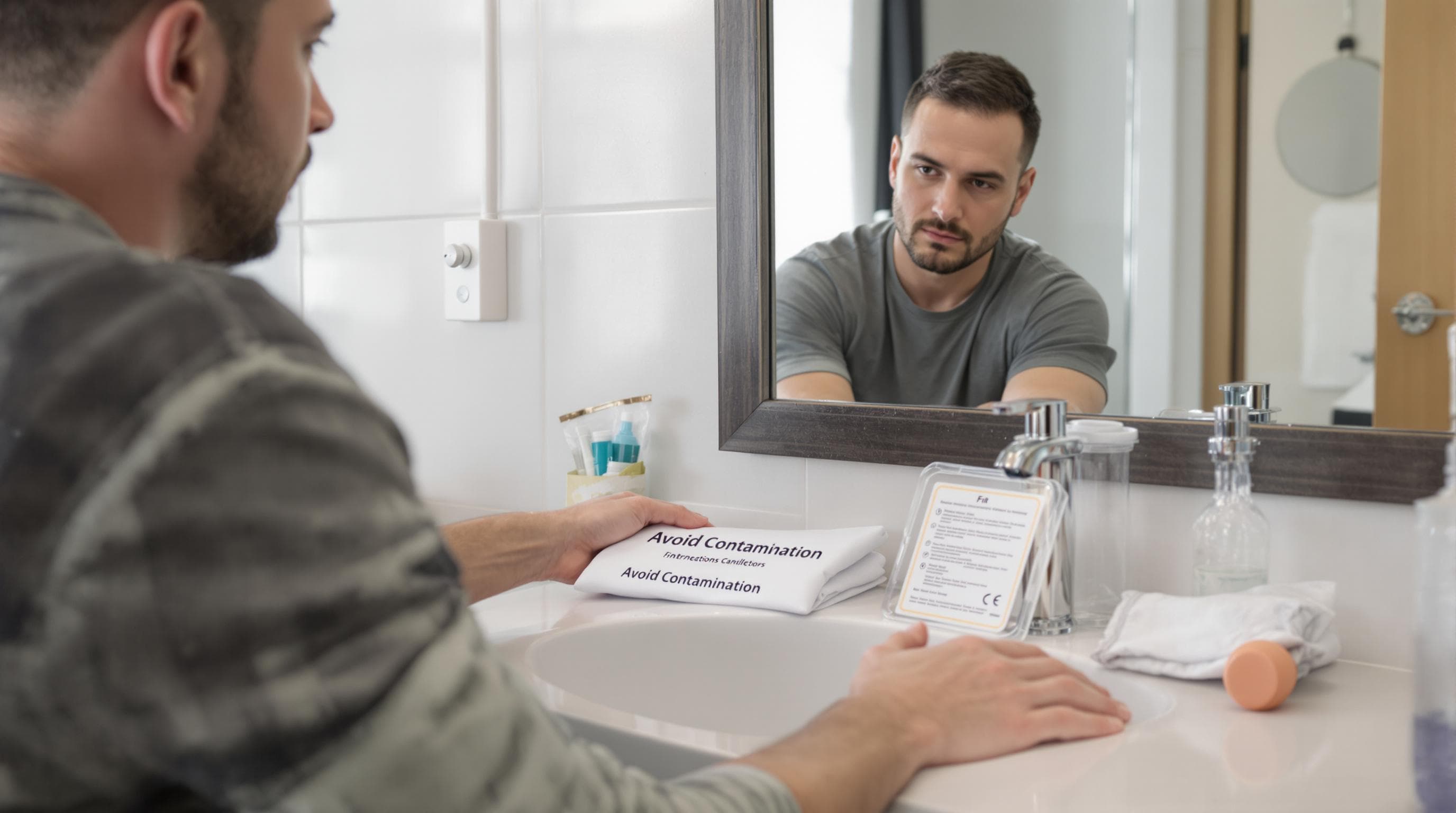Trying to collect a semen sample for fertility or after a vasectomy can feel like a small detail, but it actually holds huge consequences for your results. Here’s something most guys don’t realize. A semen sample delivered just 30 minutes too late can make all the difference between an accurate test and a wasted effort. What seems simple is often botched by common mistakes with timing, collection, or handling. Here’s what gets overlooked and why your approach to this step could change everything.
Table of Contents
- Preparing For Semen Sample Collection At Home
- Common Mistakes To Avoid During Collection
- Special Considerations After Vasectomy Surgery
- Tips For Couples Trying To Conceive Successfully
Quick Summary
| Takeaway | Explanation |
|---|---|
| Understanding Abstinence Requirements | Maintain sexual abstinence for 2 to 7 days prior to semen sample collection to optimize sperm concentration and motility. Consult your healthcare provider for specific recommendations based on individual health factors. |
| Proper Collection Techniques | Collect the entire ejaculate directly into a sterile container without using lubricants, as these can interfere with sperm quality. Create a comfortable environment to minimize stress during collection. |
| Transportation and Timing Considerations | Deliver the semen sample to the laboratory within one hour of collection while keeping it at room temperature (20°C to 37°C) to preserve sperm viability and ensure accurate test results. |
| Post-Vasectomy Semen Analysis Timing | Conduct a post-vasectomy semen analysis approximately 12 weeks after surgery, having had at least 20 ejaculations to ensure residual sperm are cleared from the system. |
| Communication and Collaborative Fertility Planning | Couples should engage in open communication and mutual support when navigating conception, including scheduling joint consultations and discussing lifestyle changes together to enhance fertility. |
Preparing for Semen Sample Collection at Home
Collecting a semen sample at home requires careful preparation to ensure accurate results for fertility testing or vasectomy confirmation. The process might seem straightforward, but several critical factors can significantly impact the quality and reliability of your sample.
Understanding Abstinence Requirements
Before collecting your semen sample, sexual abstinence plays a crucial role in obtaining optimal results. According to Cleveland Clinic, men should maintain sexual abstinence for 2 to 7 days prior to sample collection. This timeframe allows for maximum sperm concentration and motility. Shorter periods may result in lower sperm counts, while excessively long abstinence can decrease sperm quality and viability.
The ideal abstinence window varies based on individual health factors and specific testing requirements. Consulting with your healthcare provider can help determine the most appropriate timeframe for your specific situation. Some clinics might recommend a slightly different abstinence period depending on the specific fertility or vasectomy confirmation test being conducted.
Proper Collection Techniques
Collecting a semen sample requires precision and attention to detail. National Center for Biotechnology Information recommends collecting the entire ejaculate directly into a sterile, wide-mouthed container through masturbation. Avoid using lubricants, as they can interfere with sperm motility and test accuracy.
When preparing for sample collection, create a comfortable and private environment. Stress and anxiety can potentially impact sample quality, so choose a location where you feel relaxed and undisturbed. Ensure you have all necessary collection materials prepared beforehand to minimize potential complications.
Transportation and Timing Considerations
Time is critical when handling a semen sample. University of Virginia Medical Center emphasizes the importance of delivering the sample to the laboratory within one hour of collection. During transport, maintain the sample at room temperature between 20°C to 37°C to preserve sperm viability.
Proper packaging is essential to prevent sample contamination or temperature fluctuations. Most at-home semen testing kits provide specialized containers and transportation materials designed to maintain sample integrity during shipping.
Preparing for a semen sample collection involves more than just the moment of collection. Careful planning, understanding the requirements, and following precise guidelines can significantly improve the accuracy of your fertility or vasectomy confirmation test. By approaching the process methodically and staying informed, you can ensure the most reliable results possible.
Remember, each step of preparation contributes to the overall quality of your semen sample. Take your time, follow instructions carefully, and don’t hesitate to contact your healthcare provider if you have specific questions or concerns about the collection process.
Here is a table summarizing the key steps and timing recommendations for semen sample preparation and submission:
| Step | Details/Timing |
|---|---|
| Abstinence Before Collection | 2 to 7 days |
| Collection Method | Masturbation into sterile container |
| Avoid Lubricants | Yes, use none unless specified |
| Environment | Comfortable and private |
| Time Limit to Lab Submission | Within 1 hour of collection |
| Transport Temperature | 20°C to 37°C (room/body temp) |
| Contact Healthcare Provider | If unsure about instructions |
Common Mistakes to Avoid During Collection

Semen sample collection requires precision and care. Even minor errors can compromise the accuracy of fertility testing or vasectomy confirmation results. Understanding and avoiding common mistakes can significantly improve the reliability of your sample.
Contamination and Sample Handling Errors
Contamination represents one of the most critical risks during semen sample collection. National Center for Biotechnology Information warns that introducing external substances can dramatically impact sperm analysis. Common contamination sources include using non-sterile containers, touching the inside of collection vessels, or accidentally mixing the sample with soap, lotion, or other substances.
Professional laboratories recommend using only provided collection containers and avoiding any additional materials not explicitly approved for the test. Wash your hands thoroughly before collection and handle the container only by its exterior. Ensure the collection area is clean and free from potential contaminants like cleaning products, personal care items, or other substances that could interfere with the sample.
Improper Lubrication and Collection Techniques
Cleveland Clinic emphasizes the critical importance of avoiding lubricants during sample collection. Many commercial lubricants contain substances toxic to sperm, which can significantly alter test results. These products can damage sperm motility and viability, leading to potentially misleading fertility assessments.
If you struggle with sample collection, consult your healthcare provider about approved collection methods. Some at-home semen testing kits provide specific guidance on collection techniques that preserve sample integrity. Natural arousal and a comfortable, private environment are typically the best approaches for obtaining an accurate sample.
Temperature and Timing Complications
Time and temperature are crucial factors in maintaining semen sample quality. Kaiser Permanente recommends delivering the sample to the laboratory within one hour of collection, keeping it at body temperature during transport.
Common timing mistakes include:
- Delaying sample delivery beyond the recommended one-hour window
- Exposing the sample to extreme temperatures
- Storing the sample in inappropriate conditions
- Failing to follow specific transportation instructions provided with the collection kit
Extreme temperatures can rapidly deteriorate sperm quality. Cool temperatures can slow sperm metabolism, while excessive heat can damage or kill sperm cells. Most testing protocols require maintaining the sample between 20°C to 37°C during transportation.
Preparing in advance can help avoid these potential pitfalls. Review all collection instructions carefully before the day of sample collection. Ensure you have all necessary materials ready and understand the exact process for collection and transportation.
Remember that each step matters. A single mistake can invalidate your entire sample, potentially requiring a repeat collection and delaying your fertility assessment or vasectomy confirmation. Take your time, follow instructions precisely, and when in doubt, contact your healthcare provider or the testing laboratory for guidance.
The following table outlines common semen sample collection mistakes and how to avoid them:
| Mistake | Why It Matters | How to Avoid |
|---|---|---|
| Using non-sterile container | Introduction of contaminants | Use only the provided sterile container |
| Touching inside of container | Risk of external contamination | Handle by exterior only |
| Using lubricants or lotions | Can damage sperm and compromise results | Avoid all lubricants and lotions |
| Delayed delivery (over 1 hour) | Sperm quality deteriorates/inaccurate results | Transport to lab within 1 hour |
| Exposure to extreme temperatures | Damages or kills sperm | Keep sample at 20°C to 37°C |
| Inadequate abstinence period | May reduce sperm count or quality | Abstain for 2-7 days as instructed |
Special Considerations After Vasectomy Surgery
Undergoing a vasectomy is a significant decision in a man’s reproductive journey. While the procedure is relatively straightforward, the post-surgical period requires careful attention and specific steps to ensure successful sterilization and recovery.
Post-Surgical Semen Analysis Timing
According to University of Virginia Medical Center, post-vasectomy semen analysis (PVSA) should be conducted approximately 12 weeks after the surgical procedure. This timeframe is critical because it allows sufficient time for remaining sperm to be cleared from the reproductive tract.
During these 12 weeks, patients are advised to use alternative contraception. The recommended protocol involves completing at least 20 ejaculations before submitting the first semen sample for analysis. This helps ensure that any residual sperm are fully expelled from the reproductive system. Patients should carefully track their ejaculations and consult with their healthcare provider about the specific requirements for their individual case.
Sample Collection Protocols
Post-vasectomy semen sample collection requires precision and adherence to specific guidelines. Research from medical experts emphasize the importance of collecting the entire ejaculate through masturbation into a sterile container. Avoid using lubricants or condoms during collection, as these can interfere with sperm analysis.
Maintaining proper sample temperature is crucial. The sample must be delivered to the laboratory within one hour of collection, kept at body temperature during transport. This ensures accurate assessment of sperm motility and helps determine the success of the vasectomy procedure. Our comprehensive guide on post-vasectomy testing provides additional insights into this critical process.
Understanding Potential Complications
While vasectomies are generally safe, patients should be aware of potential post-surgical considerations. Vasectomy complications can occur, though they are relatively rare. Some men may experience temporary discomfort, swelling, or bruising in the surgical area. These symptoms typically resolve within a few days to weeks.
It’s essential to monitor for any signs of infection or prolonged pain. Unusual symptoms such as significant swelling, fever, or intense discomfort should prompt immediate consultation with a healthcare provider. Most men recover quickly and can return to normal activities within a week, but individual recovery experiences may vary.
The post-vasectomy period requires patience and careful adherence to medical guidance. Multiple semen analyses might be necessary to confirm complete sterilization. Some men may not achieve zero sperm count in their first test, which is why follow-up analyses are crucial.
Remember that successful vasectomy confirmation depends on strict compliance with medical instructions. Take time to understand each step of the process, communicate openly with your healthcare provider, and approach post-surgical care with diligence and attention to detail. Your commitment to following proper protocols ensures the most accurate assessment of the procedure’s success.
Tips for Couples Trying to Conceive Successfully
Navigating the journey of conception requires a comprehensive understanding of reproductive health, precise timing, and collaborative effort between partners. Successful conception involves more than just collecting a semen sample it demands strategic planning and informed approaches.
Optimizing Semen Sample Quality
World Health Organization recommends collecting semen samples after 2 to 7 days of sexual abstinence to maximize sperm quality. This carefully timed abstinence period allows for optimal sperm concentration and motility, increasing the likelihood of successful fertilization.
Couples should understand that sperm quality is influenced by multiple factors. Clear signs of healthy sperm include proper concentration, motility, and morphology. Lifestyle factors such as diet, exercise, stress management, and avoiding harmful substances can significantly impact sperm health. Regular medical consultations and comprehensive fertility assessments can provide deeper insights into reproductive potential.
Precise Sample Collection and Handling
Mayo Clinic emphasizes the critical importance of avoiding lubricants during semen collection. Many commercial lubricants contain substances that can impair sperm movement and function, potentially reducing fertility chances.
Precision in sample collection extends beyond avoiding lubricants. The entire collection process requires meticulous attention to detail. Maintain room temperature, use sterile collection containers, and transport the sample to the laboratory within one hour. Each step plays a crucial role in preserving sperm viability and obtaining accurate fertility assessments.
Communication and Collaborative Fertility Planning
Successful conception is a shared journey that requires open communication and mutual support. Fertility clinic communication guidelines highlight the importance of both partners being actively involved in the fertility process.
Consider these collaborative strategies:
- Schedule joint medical consultations
- Discuss lifestyle modifications together
- Share the emotional aspects of fertility challenges
- Develop a supportive, stress-reducing environment
- Maintain transparency about individual and collective health goals
Understanding that fertility is a complex, multifaceted process helps couples approach conception with patience and scientific insight. Medical technology and at-home testing options provide unprecedented opportunities for comprehensive reproductive health monitoring.
Remember that every fertility journey is unique. While general guidelines offer valuable direction, individual experiences can vary significantly. Professional medical guidance, mutual support, and a holistic approach to reproductive health are key to navigating this important life chapter successfully.
Frequently Asked Questions
What should I do to prepare for semen sample collection at home?
To prepare for semen sample collection at home, maintain sexual abstinence for 2 to 7 days prior to collection, use a sterile container, avoid lubricants, and create a comfortable and private environment for collection.
How long should it take to deliver a semen sample to the lab after collection?
A semen sample should be delivered to the laboratory within one hour of collection to ensure the best accuracy in test results and to maintain sperm viability.
What common mistakes should I avoid when collecting a semen sample?
Avoid using non-sterile containers, touching the inside of the collection vessel, using lubricants, delaying delivery to the lab, and exposing the sample to extreme temperatures to prevent contamination and ensure accurate results.
When is the appropriate time to conduct a semen analysis after a vasectomy?
Post-vasectomy semen analysis should be performed approximately 12 weeks after the surgery, ensuring at least 20 ejaculations have occurred to clear residual sperm from the reproductive system.
Recommended
- Troubleshooting Semen Testing Issues: Vasectomy and Fertility, 2025
- Why Test Semen Sample: Answers for Vasectomy & Fertility 2025
- Semen Analysis and Fertility Planning: Insights for Vasectomy and Conc
- Semen Analysis Timing: Best Practices for Vasectomy and Fertility 2025
- Supplement Review: FertilAid for Men by Fairhaven Health - Dr. Bell Health
- Donor Agreements Explained Simply - Law & More




